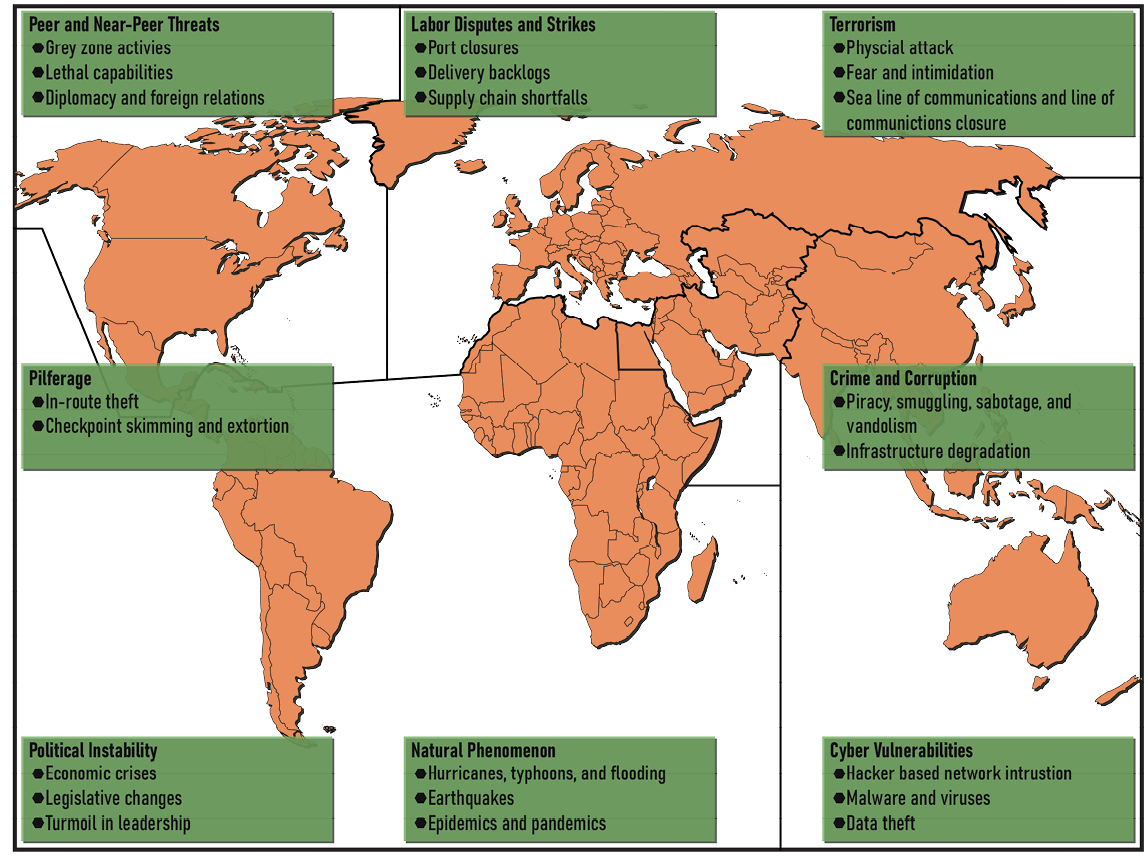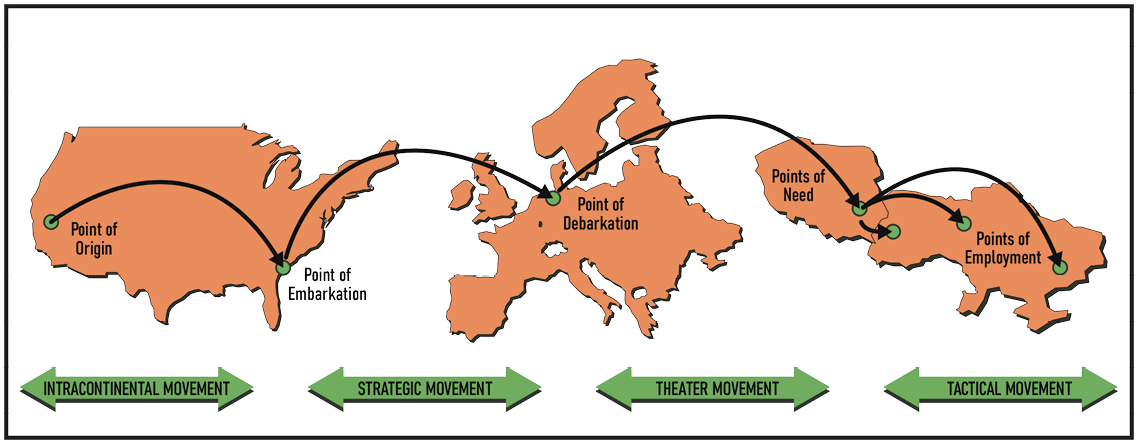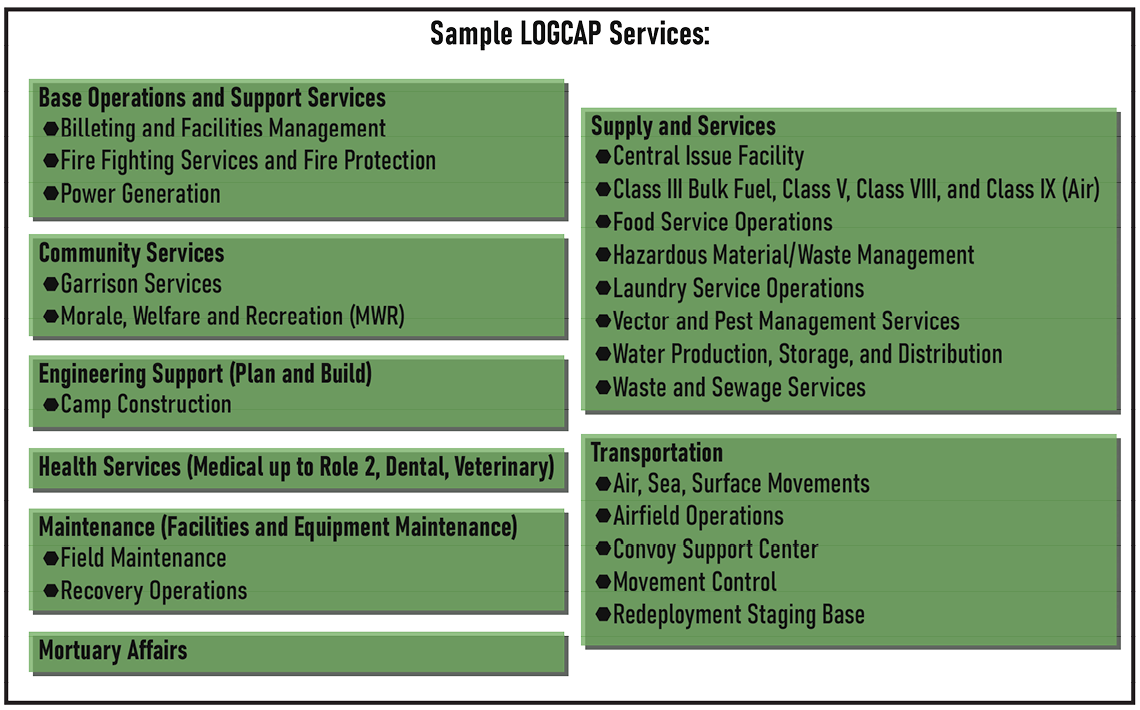Intelligence Support to Sustainment
Introduction
In today’s volatile geopolitical climate, it is crucial to emphasize intelligence support for sustainment operations when building partner capacity. In conflict, tactical sustainment elements are likely to be near the front lines, where partners may not have the same level of protection as that provided by large coalition forces. In these circumstances, intelligence analysts use threat reporting to provide sustainment forces with updates necessary to mitigate the threat. Intelligence drives sustainment operations by providing timely and accurate analysis so that sustainment forces can effectively and efficiently reduce risk and increase operational success. Integrating intelligence into sustainment operations is a strategic requirement of today’s complex and dynamic geopolitical landscape. Organizations like the U.S. Army Sustainment Command (ASC) have a multi-echeloned perspective on maintaining global situational awareness of impacts on sustainment. Within organizations that are force providers like ASC, intelligence support to sustainment requires situational awareness from the strategic to the tactical level.
ASC, a two-star major subordinate command of U.S. Army Materiel Command, is headquartered at Rock Island Arsenal, Illinois. It is not just a logistics integrator but also manages sustainment operations worldwide. Its global footprint consists of 7 Army field support brigades (AFSBs) in 20-plus countries and 32 states committed to sustaining Army, joint, and multinational forces through adaptive logistics.
The scope and complexity of ASC’s responsibility is a testament to its crucial role in global logistics. Field Manual 4-0, Sustainment Operations, states:
ASC integrates and synchronizes the delivery of [U.S. Army Materiel Command] USAMC and materiel enterprise capabilities at echelon from the theater strategic level of warfare to the operational level of warfare. ASC delivers materiel readiness, force generation, and power projection and sets the conditions for future readiness at home station. ASC forward-stationed capabilities provide command and control to all USAMC assets in theater, shape the logistics environment, and help set the theater to accelerate force reception into theater. Deployable logistics support elements (LSEs) provide expeditionary corps and divisions the ability to rapidly integrate into the theater delivery of USAMC capabilities at echelon for responsive support to Soldier priorities.…It is responsible for integrating logistics support with strategic partners and links the national sustainment base with the expeditionary Army. Major mission areas include logistics synchronization in support of the Regionally Aligned Readiness and Modernization Model, [Army pre-positioned stocks] APS, materiel management, and the Logistics Civil Augmentation Program (LOGCAP). Mission execution is through a global network of organizations to include the ASC staff, Army field support brigades (AFSBs), Army field support battalions (AFSBns), logistics readiness centers (LRCs), and LSEs embedded at the division and corps levels.1
ASC G-2 Intelligence Support Element
With a mission that has global implications, the ASC G-2 intelligence support element provides ASC leadership with insights concerning threats to sustainment operations. Notable threats to the global logistics enterprise and ASC operations include near-peer threats (i.e., China, Russia, and Iran), labor disputes and strikes, political instability, and terrorism. For example, increased Chinese aggression since the January 2024 Taiwanese elections could result in new operational requirements for ASC. Furthermore, labor disputes or strikes at notable ports or border crossings can delay vital shipments to the intended recipients, which could impact the sustainment enterprise.
The ASC G-2 intelligence support element provides comprehensive intelligence products, delivering timely, accurate, relevant, and tailored intelligence analysis and assessments to the ASC commanding general, headquarters staff, and subordinate units to mitigate these threats. To aid command decision making, the intelligence support element produces strategic and operational intelligence that addresses both lines of effort and priority intelligence requirements, while prioritizing the most important issues with potential wide-ranging impacts on the sustainment operational environment. These products can include the assessment of critical regional and national actor capabilities, intentions, and strategies, as well as emerging enemy capabilities likely to affect logistics operations, economic stability, and foreign trade and development. The intelligence support element also provides intelligence and threat data supporting the command’s antiterrorism, force protection, operational security, and training programs.
The intelligence support element conducts in-depth research and detailed analysis to integrate intelligence from all intelligence community sources. It then meticulously filters the intelligence through a sustainment operations “prism” to prepare its analytical products. The intelligence support element’s intelligence production is not focused solely on threats to manning, arming, fueling, maintaining, transporting, and protecting sustainment forces but also emphasizes threats to sustainment operations from the point of embarkation to the point of need, underlining the inherent complexity of their task.
While not robust in number, the intelligence support element is task-organized to provide global intelligence support. Company-grade officers and noncommissioned officers conduct in-depth analysis of threats to ASC operations within the combatant commands (CCMDs), collaborating with organic sustainment organizations such as theater or expeditionary sustainment commands to provide tailored support for CCMD intelligence analysis. Additionally, the intelligence support element provides intelligence support to ASC plans and operations through daily updates to decision makers on the impact to current operations. This support comes in the form of tailored briefs covering geopolitical effects on current operations and predictive analysis of potential operational requirements that could result in presidential directives for materiel support. The intelligence support element can also provide topographic and terrain analysis support to ASC leaders through its geospatial engineer in the form of maps and graphics.
Intelligence Support to Sustainment
AFSBs have specific mission sets that focus on providing a link between the generating force and the operational force within their assigned areas. AFSBs are also crucial to coordinating strategic capabilities from the Army Materiel Command and the ASC to the operational force while supplying Logistics Civil Augmentation Program (LOGCAP) support throughout all phases of operations.
AFSB S-2s have a unique intelligence mission set as they provide pertinent information to the brigade commander, emphasizing sustainment and power projection. AFSB S-2s must deliver more than the traditional threat action reporting; they also must provide predictive analysis on possible LOGCAP or Army pre-positioned stocks (APS) requirements. The reachback support they receive from the intelligence support element and the S-2’s connection with their respective theater or expeditionary sustainment commands enables this analysis. By synchronizing with the theater or expeditionary sustainment commands and ASC, the AFSB S-2s can understand the sustainment picture within their area of responsibility to focus on predictive analysis rather than reactive analysis.
The Power of Open-Source Intelligence
Open-source intelligence (OSINT) has recently become a discipline vital for information and intelligence collection within ASC because it provides opportunities for real-time updates on operational impacts such as maritime traffic, port delays, and rail information. Additionally, due to ASC’s unique structure and sizable civilian workforce, most of whom do not have access to classified networks, disseminating analytical products at an unclassified level maximizes the intelligence support to the available audience and allows the intelligence support element to serve most ASC personnel better. Accordingly, the intelligence support element utilizes OSINT in support of sustainment operations in several ways:
- Situational Awareness: Publicly available information and OSINT allow analysts to monitor real-time information. This provides context and a comprehensive understanding of threats to global military logistics.
- Risk Assessment: Publicly available information databases provide information on potential risks to military logistics, allowing ASC to mitigate risk and maintain operational continuity.
- Geopolitical Analysis: Analytical data on international relations, global crises, and regional tensions can inform ASC leaders of potential impacts to military sustainment operations. This analysis is essential for mitigating risk and strategic planning.
- Predictive Analysis: OSINT can provide analysts with historical context and current public sentiment, enabling intelligence professionals to provide predictive analysis on future sustainment support requirements.
As OSINT has become established as an intelligence community discipline, ASC increasingly utilizes it to create daily intelligence products focused on global threats to logistics in the form of a daily intelligence summary and a global update, which the intelligence support element disseminates to over 500 personnel within Army logistics organizations and a myriad of organizations that focus on threats to logistics, including Transportation Command, Development Command, and sister services. Upon establishing its OSINT mission and authorities, ASC broadened its scope of intelligence product dissemination to the greater intelligence community as the only Army organization focused solely on intelligence support to sustainment.
Intelligence Support to the Logistics Civil Augmentation Program
LOGCAP provides sustainment, minor construction, and other services through Army contractor assets to CCMD commanders, joint operations, allies, and federal agencies. Typically, LOGCAP provides tailorable packages of base logistics services in austere or hostile environments with little or no Army support infrastructure to enable military operations. Some previous LOGCAP operations include:
- Base logistics support to the U.S. Central Command in Afghanistan, Iraq, Kuwait, and Saudi Arabia.
- Exercise support to the U.S. Africa Command.
- Mission and installation support to the U.S. European Command.
- Mission and installation support to the U.S. Northern Command at the National Training Center.
- Construction and operations support for five living areas during Operation Allies Welcome, a noncombatant evacuation operation.
The intelligence support element enables LOGCAP operations by providing support through predictive analysis to identify threat activities and trends that could impact the mission. These efforts inform the intelligence products produced for LOGCAP leaders and planners. These products can range from topographic imagery analysis and identification of potential threats to proposed LOGCAP site locations to threat briefs for activated LOGCAP personnel, directly impacting the level of personal protective equipment their mission will require. The intelligence support element additionally supports LOGCAP noncombatant evacuation operations by monitoring indicators for events of unrest or national disasters, thereby providing LOGCAP personnel with indications and warnings to support their preparation, planning, and risk mitigation efforts, ensuring successful operations. Simply put, the intelligence support element provides detailed intelligence support from the strategic to the tactical level, enabling LOGCAP operations to have the greatest impact.
Army Pre-Positioned Stocks Intelligence Support
APS is an Army program that stores and maintains equipment sets around the globe for use when a CCMD commander requires additional capabilities. These stocks—identified as APS-1 (United States), APS-2 (Europe), APS-3 (Afloat), APS-4 (Northeast Asia), and APS-5 (Southwest Asia)—are available to support all CCMD commanders’ missions, not only in contingencies but also for major exercises and humanitarian missions. The sustainment enterprise utilizes exercises such as Operation Pathways (formerly Pacific Pathways) in the U.S. Indo-Pacific Command to test operational and tactical employment of logistics and the use of APS in a large-scale combat operation. This exercise program requires sustainment headquarters, such as the 8th Theater Sustainment Command, to coordinate with multiple AFSBs and the ASC for APS requests and dynamic employment.
The intelligence support element enhances APS operations by delivering tailored intelligence products for each existing and projected APS location and its corresponding AFSB. This ensures that the AFSB, APS, and ASC leadership receive up-to-date threat reports, enabling them to make informed decisions on safeguarding the APS assets. The intelligence support element also provides the ASC leadership with predictive analysis within the individual areas of responsibility, allowing them to anticipate and address emerging APS requirements effectively and efficiently.
Support During a Crisis
With a global response mission, the ASC G-2 maintains situational awareness to provide the most up-to-date information and predictive analysis on global crises. Since Russia began its invasion of Ukraine in February 2022, the United States has issued presidential directives aimed at providing military assistance to Ukraine. The 405th AFSB is critical to this mission because it provides materiel enterprise support to U.S. forces in Europe and Africa.
In support of the 405th AFSB, the ASC G-2 intelligence support element communicated with other intelligence units in the theater, including the U.S. European Command J-2 Joint Analysis Center, the 66th Military Intelligence Brigade (Theater), and the XVIII Airborne Corps G-2, to ensure that commanders at all levels were aware of threats to shipments from the point of embarkation, to the myriad points of debarkation, to the final point of need. Additionally, the dynamic threat environment, coupled with automation and the inception of real-time troubleshooting telemaintenance, required an emphasis on the cyberspace threat to all ASC assets in the theater to identify any potential delay to the requested military assistance. As the conflict in Ukraine continues, the ASC G-2 intelligence support element and the 405th AFSB continue to monitor threats to military aid, ensuring the uninterrupted flow of materiel support to Ukraine.
Conclusion
Through this article, we have offered broad examples of how intelligence professionals support logistics in no small part due to the unique nature of the logistical challenges. Because sustainers must meet the warfighter’s needs worldwide, there cannot be a “one size fits all” approach to how the Military Intelligence Corps supports the sustainers. Looking toward tomorrow’s fight, the information that logisticians require will undoubtedly become more diverse. As the U.S. military continues its focus on large-scale combat operations, intelligence support to sustainment must meet the increased demand for relevant and timely intelligence. The emerging requirements may take the form of analyzing sea states for their shipping capacity and capability to load and unload goods, analyzing secondary and tertiary effects of modernized militaries on the battlefield, or monitoring environmental and social threats that could lead to a noncombatant evacuation operation.
The intelligence support provided to the logistics field can take the form of intelligence support for APS, LOGCAP, and interactions with partner nations; however, it is not limited to these topics. We can expect the demand from the sustainment enterprise to increase as warfare continues to evolve. Therefore, in order to enable the sustainment community to guarantee the continuation of force projection and the capacity to “fix forward,” the scope and scale of intelligence support to sustainment must expand to provide intelligence from the tactical to the strategic level.
Endnote
1. Department of the Army, Field Manual 4-0, Sustainment Operations (Washington, DC: U.S. Government Publishing Office, 14 August 2024), 30.
LTC Alexander Corbin is the Deputy G-2 for the U.S. Army Sustainment Command, Rock Island Arsenal, IL. He previously served as the Director of the Joint Intelligence Support Element, NATO Special Operations Component Command–Afghanistan/Special Operations Joint Task Force–Afghanistan, Bagram Air Base, Afghanistan. He holds a master of science in strategic intelligence from the National Defense Intelligence College and a master of arts in military history (intelligence) from the American Military University.
CPT Ariel Ayala is an intelligence production manager for the U.S. Army Sustainment Command, Rock Island Arsenal, IL. He previously served as an intelligence officer for the 513th Military Intelligence Brigade (Theater), Fort Eisenhower, GA. His deployments include Afghanistan and the U.S. Central Command areas of responsibility, serving as an operational management team officer in charge and horizontal engineer. CPT Ayala holds a master of arts in intelligence and security studies from the Citadel and the open-source intelligence and theater sustainment planner skill identifiers.
CPT Tyler Eagan is an intelligence production manager for the U.S. Army Sustainment Command in Rock Island Arsenal, IL. He previously served as the S-2 for the 401st Army Field Support Brigade at Camp Arifjan, Kuwait. He deployed to the U.S. Central Command area of responsibility, where he supported Operations Inherent Resolve and Spartan Shield.
CPT John Seman serves as the G-2 operations officer for the U.S. Army Sustainment Command, Rock Island Arsenal, IL. He previously served as an assistant professor of military science in the Golden Lions Army Reserve Officers’ Training Corps Battalion at California State University, San Bernardino, CA. He deployed to Afghanistan in support of Operation Freedom’s Sentinel.




